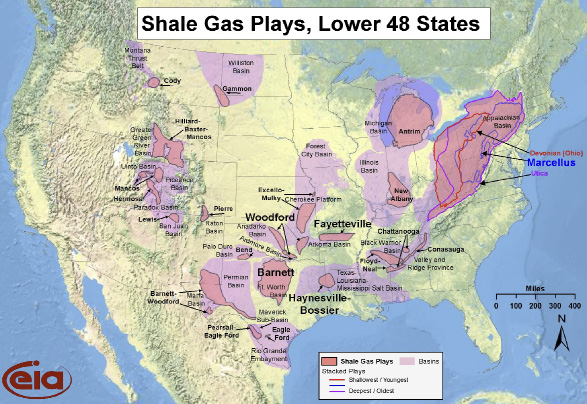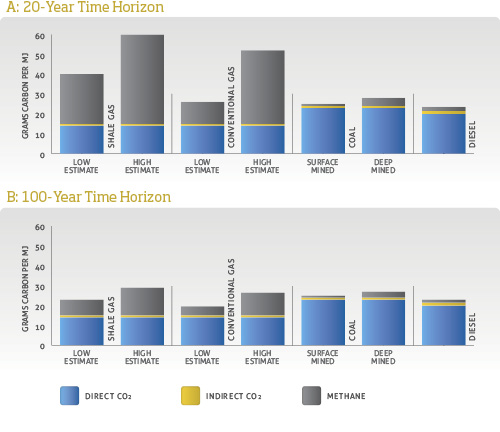
The myth of ‘clean’ natural gas is contaminating the debate about America’s energy future.
Given the widespread public rejection of coal—the dirtiest fossil fuel that deserves the reputation it earned itself—the gas industry has worked very hard to portray its product as a “clean” energy “alternative” fuel. Demonstrating the success of its lobbying and advertising campaigns, even the federal government increasingly refers to gas as a “clean”[1] and “alternative”[2] fuel. President Barack Obama has bought into the myth, including natural gas in his 2011 State of the Union definition of “clean energy sources.”[3]
Gas, a polluting fossil fuel, is derived from non-renewable sources of organic material formed millions of years ago.[4] It is drilled for and extracted from the earth through invasive procedures, threatening public health and the environment, especially in areas of the country with lots of drilling activity.[5]
The production, transport and burning of natural gas produces significant air pollution. Methane, the main component of natural gas, is a potent greenhouse gas (GHG), more than 20 times as effective at trapping heat in the atmosphere as carbon dioxide (CO2).[6] Other natural gas emissions include carbon dioxide (CO2), sulfur dioxide (SOX), nitrogen oxides (NOX), carbon monoxide (CO), particulates, volatile organic compounds (VOCS) including benzene, and more pollution.[7]
In fact, in rural and urban areas of the western United States where oil and gas drilling operations are abundant, air quality is significantly impacted, particularly from ground level ozone (smog).[8] The Associated Press recently reported that Wyoming’s air quality is worse than Los Angeles’ due to gas development.[9] There are increasing signs that drilling operations in the Marcellus shale region in the eastern U.S. present air pollution concerns as well.[10] Smog pollution from drilling can travel up to 200 miles from the gas production area, causing widespread damage to human and environmental health.[11]
Due to the increasingly urgent threat posed by global climate change, natural gas is often promoted as an ideal interim energy source (or “bridge fuel”) in the transition away from coal and oil towards renewable energy. But as the Council of Scientific Society Presidents—which represents 1.4 million scientists from more than 150 scientific disciplines - reported to the Obama administration in May 2010, “some energy bridges that are currently encouraged in the transition from GHG-emitting fossil energy systems have received inadequate scientific analysis before implementation, and these may have greater GHG emissions and environmental costs than often appreciated.” The development of unconventional gas from shale deposits, the Council warns, is an “example where policy has preceded adequate scientific study.”[12]
There has been little scientific focus on the topic of climate impacts associated with the production of gas from unconventional deposits. However, the few studies that have been conducted offer a sharp contradiction to the popularized notion that gas is a clean source of energy.
The development of unconventional gas deposits is an energy-intensive undertaking. The enormous amounts of heavy equipment needed to pump water and create adequate drilling pressure required to extract gas from shale produce significant emissions. The construction of well pads, the collection of water and disposal of wastes all entail transportation-related emissions. Much of the production on an unconventional well pad, such as horizontal drilling and hydraulic fracturing, is powered by polluting diesel engines.[13]
The Tyndall Centre for Climate Change Research estimates that CO2 emissions from gas drilling amount to 15 kg CO2 per foot drilled from diesel powered engine use alone.[14] Well depths in the Marcellus Shale, which are remarkably deep, can reach up to 8,000 feet vertically and another 11,000 feet horizontally.[15] A total well length measuring 19,000 feet would produce 285,000 kg (285 metric tones) of CO2 from diesel engines alone. When calculating associated CO2 emissions, unconventional wells are set apart from conventional wells for two reasons: extended well distance due to horizontal drilling and, more importantly, hydraulic fracturing.
Hydraulic fracturing, the Tyndall Centre reports, is the main source of CO2 emissions from unconventional gas drilling. Heavy CO2 emissions are linked back to the engine-powered fracking process, including the blending of fracturing chemicals and sand that are pumped from storage, and the high-pressure compression, injection and recovery of materials into and out of the well.[16]
After calculating key CO2 emissions from shale gas extraction, the Tyndall Centre estimates that a single well drilled once for unconventional gas will emit somewhere between 348-438 metric tonnes of CO2. As high as this figure is, it only reflects a portion of CO2 emissions and does not account for the entire spectrum of greenhouse gas (GHG) emissions from unconventional gas drilling.
Beyond the issue of CO2 emissions, there are mounting concerns regarding gas’ main component: methane. Fugitive methane is an enormous additional source of GHG emissions from gas drilling.
According to a recent lifecycle analysis performed by a team of Cornell University scientists led by Professor Robert W. Howarth, unconventional gas—particularly when it is extracted from shale using hydraulic fracturing methods—is likely to present an even greater climate disruption threat than coal and oil, the other dirty fossil fuels. Due to the substantial methane emissions from extraction, processing and transport, unconventional gas may have a greater overall GHG impact than previously understood.
Howarth and his coauthors maintain that when these lifecycles aspects are considered “the large GHG footprint of shale gas undercuts the logic of its use as a bridging fuel over coming decades, if the goal is to reduce global warming.”[17]
The most recent analysis conducted by Howarth’s team at Cornell, recently published in the peer-reviewed scientific journal Climatic Change Letters, states that on a 20-year time horizon “the GHG footprint for shale gas is at least 20% greater than and perhaps more than twice as great as that for coal when expressed per quantity of energy available during combustion.”[18]
Professor Howarth calculates that the extraction, processing and transport of natural gas, when considered in tandem with methane leaks, places natural gas ahead of other fossil fuels in terms of total greenhouse gas emissions. “The take home message of the study” says Professor Howarth, is “if you do an integration [study] of 20 years following the development of the gas, that shale gas is worse than conventional gas and is in fact worse than coal and is worse than oil.”[19]
The Cornell team has cautioned politicians and industry against a large-scale switch to natural gas, warning that the scramble to develop unconventional gas reserves without considering the full impact of the process could bring dire consequences for the global climate. The predicted increase of gas production in the US has some analysts worried that gas will not substitute for other dirty fuel sources like coal, but will instead be used in addition to other sources, further contributing to growing total fossil fuel consumption.[20] Despite rapidly increasing domestic production rates, some industry leaders admit that the US, due to ever increasing energy demands, will continue to be a net importer of gas.[21] The Cornell study does not provide a definitive answer on the methane issue, but it raises enough concerns to warrant both an immediate moratorium on issuing new fracking permits to gas companies and the urgent need for further study.
When Dr. Howarth released the first draft of his team’s analysis in the spring of 2010, the gas industry was quick to attack it.[22] Although Howarth’s team based their early analysis heavily on federal government estimates of methane leakage,[23] maintaining that 1.5 percent of all consumed natural gas escapes as fugitive emissions, Howarth openly admitted his work was a tentative analysis and that further clarification would be needed. Scientific research in this area is difficult due to the general lack of data and monitoring. Emission figures are better known in the coal industry than in the gas industry for a variety of reasons, “one of which is that methane is regulated in the coal mining industry and is not in the natural gas industry,” according to Dr. Howarth.[24]
However, it turns out that their early assumptions about methane leakage from shale gas—and EPA’s own estimates—were wildly lower than reality, significantly underestimating methane leakage from shale gas extracted using hydraulic fracturing. Apparently, EPA had not previously taken into account the total emissions from the extensive production, processing, venting, and transportation networks used to service natural gas wells.[25] The EPA now cautions that their 1996 authoritative report, Methane Emissions from the Natural Gas Industry, “significantly underestimated” emission sources.[26]
The EPA’s revised emission figures substantiated Howarth’s claims that fugitive methane emissions are a serious problem and should have serious implications for our interest in gas as a bridge fuel. Previously unexamined emission sources are now understood to contribute tremendous amounts of methane into the atmosphere, at rates thousands of percent higher than previously accounted for.[27]
Dr. Howarth’s team revised their own figures to incorporate the EPA’s new data and their recent analysis reflects this more startling emissions rate: “Summing all estimated losses, we calculate that during the life cycle of an average shale-gas well, 3.6 to 7.9% of the total production of the well is emitted to the atmosphere as methane. This is at least 30% more and perhaps more than twice as great as the life-cycle methane emissions we estimate for conventional gas.”[28]
These higher emissions from unconventional shale gas are significantly greater than conventional gas “due to methane emissions with flow-back fluids and from drill out of wells during well completion.”[29] Conventional wells have no flow-back because they are not drilled hydraulically and are completed without a drill out phase. In the flow-back stage alone, where a mixture of methane and fracking fluids return to the surface, unconventional wells lose between 0.6 and 3.2 percent of their lifetime production of gas.[30]
Once the well is ready for production, the drill-out phase entails the removal of plugs, allowing the previously contained gas to flow. An additional 0.33 percent of the lifetime production of gas is lost during this stage.[31]
Dr. Anthony Ingraffea of Cornell University, a hydraulic fracturing expert and contributing author on Howarth’s report, determines that the greenhouse gas footprint for both conventional and unconventional gas production has never been properly assessed. But the differences between conventional and unconventional drilling are significant, says Ingraffea, due to the drastic size increases in unconventional wells. Unconventional wells have a greater total length than conventional wells, due to their lateral extensions underground.
This greater total length means that unconventional gas wells require more and heavier drilling equipment, longer drilling time, higher probability of drilling problems, and more venting during drilling. In addition, these longer wells require more and heavier fracking equipment, more stages and volume per stage, more plugs and longer drill-out periods.
Also significant, these large-scale drilling operations produce more flowback waste and produced water, which in turn means higher volumes of waste for longer periods and more venting and flaring of gas.[32]
Much of the escaped methane is released during the well’s preparation, before the well has gone into production. During drilling, flowback, and after each stage of fracking, production of the gas is not yet possible and so, says Ingraffea, the fugitive gas is either vented or flared. Drillers often hit pockets of shallow methane which flows directly into the well. This early methane also must be vented or flared.
“I should point out,” he adds, “that there are many countries in the world where flaring is illegal.”[33]
When companies flare they are not only wasting gas through inefficient practices, gas which landowners are not paid for, but they are emitting potent greenhouse gas directly, squandered, into the atmosphere. In order to keep their estimates conservative, the Cornell team averaged that the gas industry splits their waste gas equally between venting and flaring.
Due to limited reporting on methane emissions, the team also excluded shallow gas venting, accidents, incidents, methane migration from around the well and up the well before production. This means that the startling emission rates that the study presents may turn out to be lower than the reality.

A close look at methane is essential to understanding the global warming potential (GWP) of gas, says Professor Howarth, because methane interacts differently with the atmosphere than carbon dioxide. It is important to note that the Cornell team’s findings are based on limited data, and must be replicated by further scientific study.
Figures on fugitive emissions of methane from coal and oil have not been properly assessed, either. All fossil fuel extractive industries should be compelled to collect and release complete data on fugitive emissions. Until that happens, much uncertainty will remain.

Comparison of greenhouse gas emissions from shale gas with low and high estimates of fugitive methane emissions, conventional natural gas with low and high estimates of fugitive methane emissions, surface-mined coal, deep-mined coal, and diesel oil. A is for a 20-year time horizon, and B is for a 100-year time horizon.
Estimates include direct emissions of CO2 during combustion (blue bars), indirect emissions of CO2 necessary to develop and use the energy source (yellow bars), and fugitive emissions of methane, converted to equivalent value of CO2 as described in the text (gray bars).
http://www.springerlink.com/content/e384226wr4160653/fulltext.pdf
Because the GWP is the “integrated influence of a gas compared to carbon dioxide on global warming over some defined period of time,” the time frame influences how one understands a given gas. In the instance of methane, Howarth maintains, the time horizon is crucial, “because methane doesn’t hang around in the atmosphere as long as carbon dioxide.
Methane is in the atmosphere for about a decade, carbon dioxide is in the atmosphere for about a century. So in a short period, right after emission, methane is an incredibly potent greenhouse gas, but over a century it’s gone.”[34]
Howarth performed two basic calculations in his methane analysis, one according to a 100-year time frame, and a second according to a 20-year time frame. Standard figures place methane at 21 times more potent than CO2 on a 100-year scale, and 72 fold more potent on a 20-year scale. These figures, says Howarth, have recently been revised to 33 and 105 respectively, new figures that the Intergovernmental Panel on Climate Change advised Howarth to follow.[35]
Methane, new research has shown, beyond having a high warming potential, actually prevents atmospheric cooling because of the indirect effects the gas has on aerosol formation in the atmosphere.[36] Understanding these types of integrated effects on a shorter time horizon is necessary, says Howarth, “because we want to be solving climate change now and we need to worry about those short term aspects.”[37] The Cornell team challenges the notion that shale gas can ever be considered “clean.” Much worse than coal for the climate over the next two decades, and just as bad as coal over the next century, unconventional gas no longer presents itself as a worthy ‘bridge’ fuel, Howarth’s team concludes.
The EPA’s November 2010 decision to more rigorously monitor fugitive methane from the oil and gas industry is due to industry emission rates that compare to 40 million passenger cars annually. [38] Since January 1, 2011, the oil and natural gas industry is now required to report methane leakage from all industry operations. It is possible that these industry reports will contribute to even higher estimates of fugitive methane.
Despite its misleading reputation as ‘clean’ and ‘abundant,’ gas is a polluting, non-renewable energy source. In his recent testimony before the Canadian Standing Natural Resources Committee, Dr. Ingraffea stated that:
But these potential impacts have not been given due consideration and the nation has already, in some ways, committed to a gas-intensive future. “What we’re hoping to do with this study,” says Ingraffea, “is stimulate the science that should have been done before, in my opinion, corporate business plans superseded national energy strategy.”[40]
The critique takes the wind out of the gas industry’s sails, ultimately deflating the notion that gas should become the nation’s “bridge” fuel on the way to a renewable energy future. In fact, every day that society delays the transition to a truly clean, renewable energy production system represents a setback in the fight against global climate change. All fossil fuels are dirty, threatening to public health and the environment, and bad news for the global climate.
[5]http://content.usatoday.com/communities/greenhouse/post/2011/03/wyomings-smog-exceeds-los-angeles-due-to-gas-drilling/1
[21]http://www.nytimes.com/gwire/2010/03/11/11greenwire-natural-gas-from-shale-plays-create-new-world-24064.html?pagewanted=2
[23]http://www.eia.doe.gov/pub/oil_gas/natural_gas/data_publications/natural_gas_monthly/current/ pdf/table_02.pdf
[25] For an example of how these leaks are calculated see David Lewis of The Energy Collective http://theenergycollective.com/david-lewis/48209/epa-confirms-high-natural-gas-leakage-rates
[38]http://yosemite.epa.gov/opa/admpress.nsf/bd4379a92ceceeac8525735900400c27/8518e9bdc820460a852577d600591852!OpenDocument
[39] Dr. Anthony Ingraffea. Testimony before the Canadian Standing Natural Resources Committee, February 1, 2011. http://www2.parl.gc.ca/HousePublications/Publication.aspx?DocId=4918403&Language=E&Mode=1&Parl=40&Ses=3